Optimisation of the Geometric Parameters of Longitudinally Finned Air Cooler Tubes Operating in Mixed Convection Conditions
Abstract
1. Introduction
2. Calculation Model
3. Optimisation of Geometric Parameters of Heat Pump Evaporator Tubes
3.1. Assumptions for Optimisation Calculations
- − maximisation of heat flow for constant mass of the aluminium profile
- − with the equality constraint:
- − maximisation of the objective function, which is the quotient of the heat flow to the mass of the aluminium profile:
- − inlet flow rate condition, wa = 2.3 ms−1,
- − free flow condition at the outlet, p = 0 Pa
- − outside air temperature, Ta = 275.15 K,
- − temperature on the inner surface of the exchanger tube, Tw = 247.15 K.
3.2. Results of Optimisation Calculations
3.2.1. Maximisation of the Heat Flow at Minimum Mass
3.2.2. Maximising Heat Flow at Constant Mass MPR-M
4. Conclusions
5. Patents
Author Contributions
Funding
Institutional Review Board Statement
Informed Consent Statement
Data Availability Statement
Conflicts of Interest
Nomenclature
| A | surface area, (m2) |
| ai | coefficients in the Equation (9) |
| d | tube diameter, (m) |
| Dfin | fin diameter, (m) |
| Gi | objective function, (W), (Wkg−1) |
| h | equivalent fin height, (m) |
| hfin | actual fin height, (m) |
| l | length, (m) |
| L | tube height, (m) |
| MPR | fin mass, (kg) |
| n | number of fins |
| p | pressure, (Pa) |
| heat flow in the Equation (9), (W) | |
| heat flow, (W) | |
| s | fin thickness, (m),(mm) |
| t | fin spacing, (m),(mm) |
| T | temperature, (°C) |
| w | average flow rate, ms−1 |
| Symbols | |
| α | heat transfer coefficient, (Wm−2K−1) |
| ε | fin efficiency |
| φ | relative humidity, (%) |
| ρAl | aluminium density (ρAl = 2720), (kgm−3) |
| Indices | |
| a | air |
| bott | bottom |
| CFD– | CFD numerical calculations |
| exp | experimental value |
| fin | related to the finned area |
| in | related to the internal surface |
| loc | local value |
| M | related to the exchanger tubes profile model |
| max | maximum value |
| opt | optimal value |
| out | related to the external surface |
| PR | fin mass |
| top | on top |
| w | wall |
References
- Daikin Systemy Grzewcze. Daikin_katalog_2012_Ogrzewanie. Available online: https://www.daikin.pl/pl_pl/customers.html (accessed on 10 December 2020).
- Niezgoda-Żelasko, B.; Zalewski, W.; Żelasko, J. Development of Technology and Technical Documentation and Testing of a Prototype of an Air-to-Water Heat Pump, Targeted Project No. ROW-II-436/2008; Cracow University of Technology: Kraków, Poland, 2008. [Google Scholar]
- Octopus Heat Pumps is an Efficient Solution. Available online: http://www.the-green-house.net/octopus-heat-pumps-is-an-efficient-solution/ (accessed on 16 September 2011).
- Niezgoda-Żelasko, B. Intensification of the Process of Heat Exchange in Evaporators of Air Heat Pumps Working at Low Airflow Velocities; Raport of Project N N512 458040; Cracow University of Technology: Kraków, Poland, 2013. [Google Scholar]
- Niezgoda-Żelasko, B.; Żelasko, J. Free and forced convection on the outer surface of vertical longitudinally finned tubes. Exp. Therm. Fluid Sci. 2014, 57, 145–156. [Google Scholar] [CrossRef]
- Acharya, S.; Patankar, S.V. Laminar Mixed Convection in a Shrouded Fin Array. J. Heat Transf. 1981, 103, 559–565. [Google Scholar] [CrossRef]
- Maughan, J.R.; Incropera, F.P. Mixed Convection Heat Transfer with Longitudinal Fins in a Horizontal Parallel Plate Channel: Part I—Numerical Results. J. Heat Transf. 1990, 112, 612–618. [Google Scholar] [CrossRef]
- Dogan, M.; Sivrioglu, M. Experimental investigation of mixed convection heat transfer from longitudinal fins in a horizontal rectangular channel: In natural convection dominated flow regimes. Energy Convers. Manag. 2009, 50, 2513–2521. [Google Scholar] [CrossRef]
- Dogan, M.; Sivrioglu, M. Experimental investigation of mixed convection heat transfer from longitudinal fins in a horizontal rectangular channel. Int. J. Heat Mass Transf. 2010, 53, 2149–2158. [Google Scholar] [CrossRef]
- Dogan, M.; Sivrioglu, M. Experimental and numerical investigation of clearance gap effects on laminar mixed convection heat transfer from fin array in a horizontal channel-A conjugate analysis. Appl. Therm. Eng. 2012, 40, 102–113. [Google Scholar] [CrossRef]
- Zhang, Z.; Patankar, S. Influence of buoyancy on the vertical flow and heat transfer in a shrouded fin array. Int. J. Heat Mass Transf. 1984, 27, 137–140. [Google Scholar] [CrossRef]
- Al-Sarkhi, A.; Abu-Nada, E.; Akash, B.A.; Jaber, J. Numerical investigation of shrouded fin array under combined free and forced convection. Int. Commun. Heat Mass Transf. 2003, 30, 435–444. [Google Scholar] [CrossRef]
- Petrone, G.; Cammarata, G. Numerical and experimnetal analysis of natural and mixed convection heat transfer for vertically arranged DIMM. In Proceedings of the COMSOL Conference, Hannover, Germany, 4–6 November 2008. [Google Scholar]
- Das, B. Mixed Convection Heat Transfer from A Shrouded Fin Array with and without Vortex Generator. Ph.D. Thesis, Deemed University, Arunachal Pradesh, India, 2014. [Google Scholar]
- Razelos, P. A note on the heat transfer in convective fins. Wärme Stoffübertrag. 1979, 12, 113–119. [Google Scholar] [CrossRef]
- Bhargava, S.; Duffin, R.J. On the Nonlinear Method of Wilkins for Cooling Fin Optimization. SIAM J. Appl. Math. 1973, 24, 441–448. [Google Scholar] [CrossRef][Green Version]
- Mikk, I. Convective fin of minimum mass. Int. J. Heat Mass Transf. 1980, 23, 707–711. [Google Scholar] [CrossRef]
- Maday, C.J. The Minimum Weight One-Dimensional Straight Cooling Fin. J. Eng. Ind. 1974, 96, 161–165. [Google Scholar] [CrossRef]
- Ahmadi, G.; Razani, A. Some optimization problems related to cooling fins. Int. J. Heat Mass Transf. 1973, 16, 2369–2375. [Google Scholar] [CrossRef]
- Chung, B.T.F.; Zhang, B.X. Optimization of Radiating Fin Array Including Mutual Irradiations Between Radiator Elements. J. Heat Transf. 1991, 113, 814–822. [Google Scholar] [CrossRef]
- Kern, J. Zur Bewertung von Kompakt-Wärmetauschern. Wärme Stoffübertrag. 1980, 13, 205–215. [Google Scholar] [CrossRef]
- Unk, J. Verfahren zur Optimierung von Rippenrohren und der Rohrreihenzahl in Wärmerückgewinnunggeräten. Klima Kälte Heizung 1981, 2, 73–79. [Google Scholar]
- Bulck, E.V.D. Optimal Design of Crossflow Heat Exchangers. J. Heat Transf. 1991, 113, 341–347. [Google Scholar] [CrossRef]
- Niezgoda, B. Minimising Investment and Operating Costs of Heat Exchangers with Developed Heat Exchange Surfaces. Ph.D. Thesis, Cracow University of Technology, Kraków, Poland, 1992. [Google Scholar]
- Niezgoda, B. Optymalizacja termiczno-przepływowych parametrów pracy ożebrowanych wymienników ciepła (Optimisa-tion of thermal-flow parameters of finned heat exchangers). Techn. Trans. 1995, Z.-1, 126–135. [Google Scholar]
- Niezgoda-Żelasko, B.; Zalewski, W.; Pacześna, J. Optymalizacja podziałki rozstawienia lamel w chłodnicach cieczy i skraplaczach chłodzonych powietrzem (Optimisation of fin spacing in liquid coolers and air-cooled condensers). Tech. Chłod. Klim. 2000, 6, 235–239. [Google Scholar]
- Maltson, J.D.; Wilcock, D.; Davenport, C.J. Comparative performance of rippled fine plate fin and tube heat exchanger. J. Heat Transf. 1989, 111, 21–28. [Google Scholar] [CrossRef]
- Ko, T. Thermodynamic analysis of optimal curvature ratio for fully developed laminar forced convection in a helical coiled tube with uniform heat flux. Int. J. Therm. Sci. 2006, 45, 729–737. [Google Scholar] [CrossRef]
- Rustum, I.; Soliman, H. Numerical analysis of laminar mixed convection in horizontal internally finned tubes. Int. J. Heat Mass Transf. 1990, 33, 1485–1496. [Google Scholar] [CrossRef]
- Chai, J.C.; Patankar, S.V. Natural laminar convection in internally finned horizontal annuli. Numer. Heat Transf. Part A 1993, 24, 67–87. [Google Scholar] [CrossRef]
- Haldar, S.; Kochhar, G.; Manohar, K.; Sahoo, R. Numerical study of laminar free convection about a horizontal cylinder with longitudinal fins of finite thickness. Int. J. Therm. Sci. 2007, 46, 692–698. [Google Scholar] [CrossRef]
- Haldar, S.C. Laminar Free Convection Around a Horizontal Cylinder with External Longitudinal Fins. Heat Transf. Eng. 2004, 25, 45–53. [Google Scholar] [CrossRef]
- Farinas, M.-I.; Garon, A.; Saint-Louis, K. Study of heat transfer in a horizontal cylinder with fins. Rev. Gén. Therm. 1997, 36, 398–410. [Google Scholar] [CrossRef]
- Ibrahim, E.; Moawed, M. Forced convection and entropy generation from elliptic tubes with longitudinal fins. Energy Convers. Manag. 2009, 50, 1946–1954. [Google Scholar] [CrossRef]
- Kundu, B. Beneficial design of unbaffled shell-and-tube heat exchangers for attachment of longitudinal fins with trapezoidal profile. Case Stud. Therm. Eng. 2015, 5, 104–112. [Google Scholar] [CrossRef]
- Lin, M.; Wang, Q.W. Turbulent heat transfer performance of internally longitudinally finned tubes. WIT Trans. State Art Sci. Eng. 2013, 63, 185–210. [Google Scholar]
- Awasarmol Umesh, V.; Pise Ashok, T. An experimental investigation of natural convection heat transfer anhancement from perforated rectangular fins array at different inclinations. Exp. Therm. Fluid Sci. 2015, 68, 145–154. [Google Scholar] [CrossRef]
- Kast, W.; Klan, H. Wärmeübergang durch freie Konvection an umströmten Körpern. In VDI-Wärmeatlas; VDI: Düsseldorf, Germany, 1991; pp. Fa1–Fa7. [Google Scholar]
- Yazicioglu, B. Performance of Rectangular Fins on a Vertical Base in Free Convection Heat Transfer. Master’s Thesis, Middle East Technical University, Ankara, Turkey, 2005. [Google Scholar]
- Gnielinski, V. Wärmeübergang bei erzwungener einphasiger Strömung. In VDI-Wärmeatlas; VDI: Düsseldorf, Germany, 1991; pp. Ga1–Ga2. [Google Scholar]
- Mahdi, Q.S.; Abbod, S.A.; Abbas, F.A. Investigation of heat transfer augmention from U-longitudinal finned tube heat ex-changer. Adv. Energy Power 2015, 3, 19–28. [Google Scholar] [CrossRef]
- Pronobis, M. Prenos tepla ve svazcich zebrovanych trubek. Energetika 1987, 12, 572–575. [Google Scholar]
- Kopeć, P.; Niezgoda-Żelasko, B. Heat transfer on the outer surface of vertical longitudinally finned tubes. In IOP Conference Series: Earth and Environmental Science; IOP Publishing: Bristol, UK, 2019; Volume 214, p. 012058. [Google Scholar]
- Ansys Fluent Theory Guide; Relase 14.0. 2011. Available online: https://www.scribd.com/doc/140163341/Ansys-Fluent-14-0-Theory-Guide (accessed on 10 December 2020).
- Kopeć, P.; Niezgoda-Żelasko, B. Modeling of the heat transfer process in an air heat pump fanless evaporator. MATEC Web Conf. 2018, 240, 05012. [Google Scholar] [CrossRef]
- Niezgoda-Żelasko, B.; Żelasko, J.; Zalewski, W. Longitudinal Finned Tube, Utility Model No. PL 66649; Patent Office of the Republic of Poland: Warszawa, Poland, 2011. [Google Scholar]
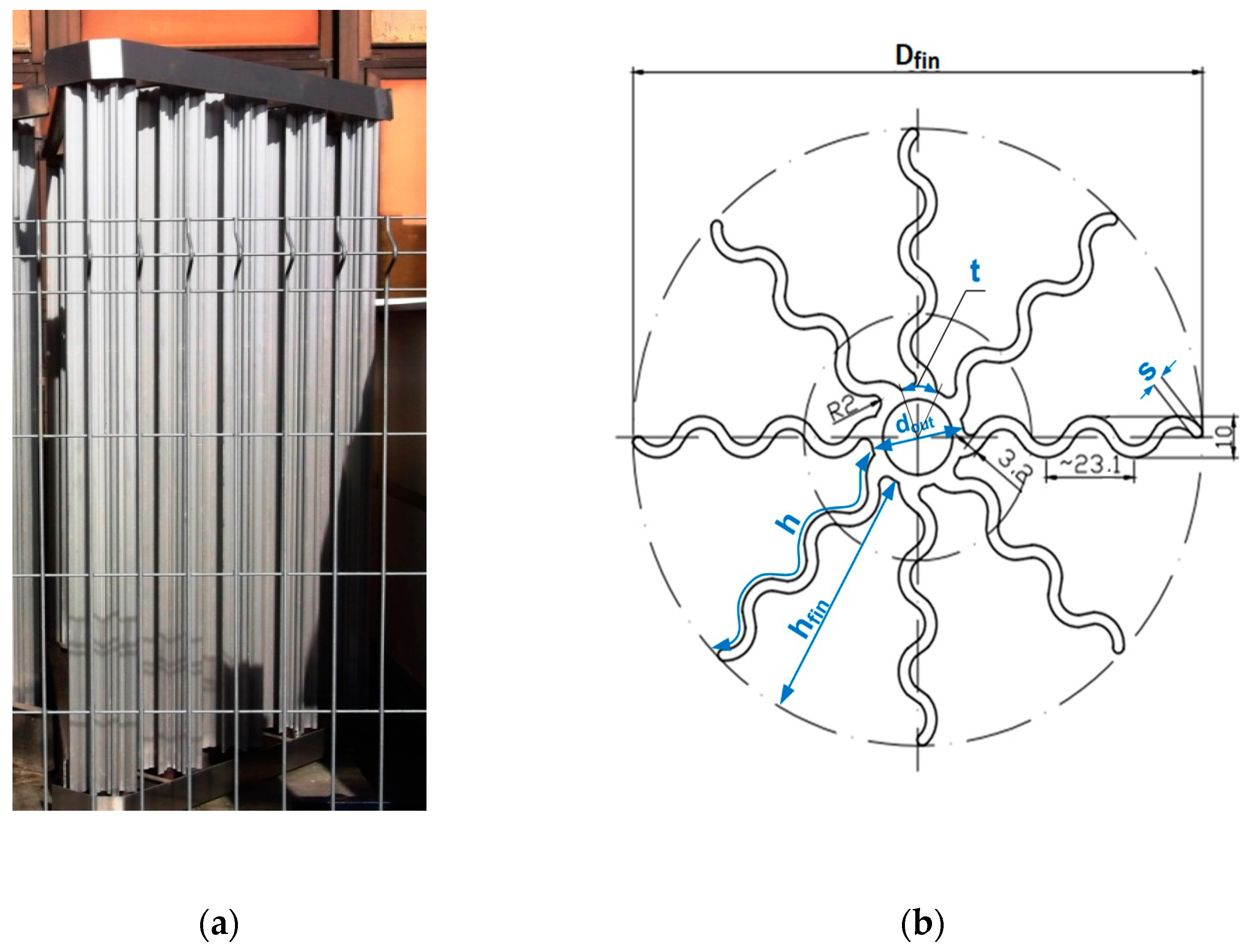
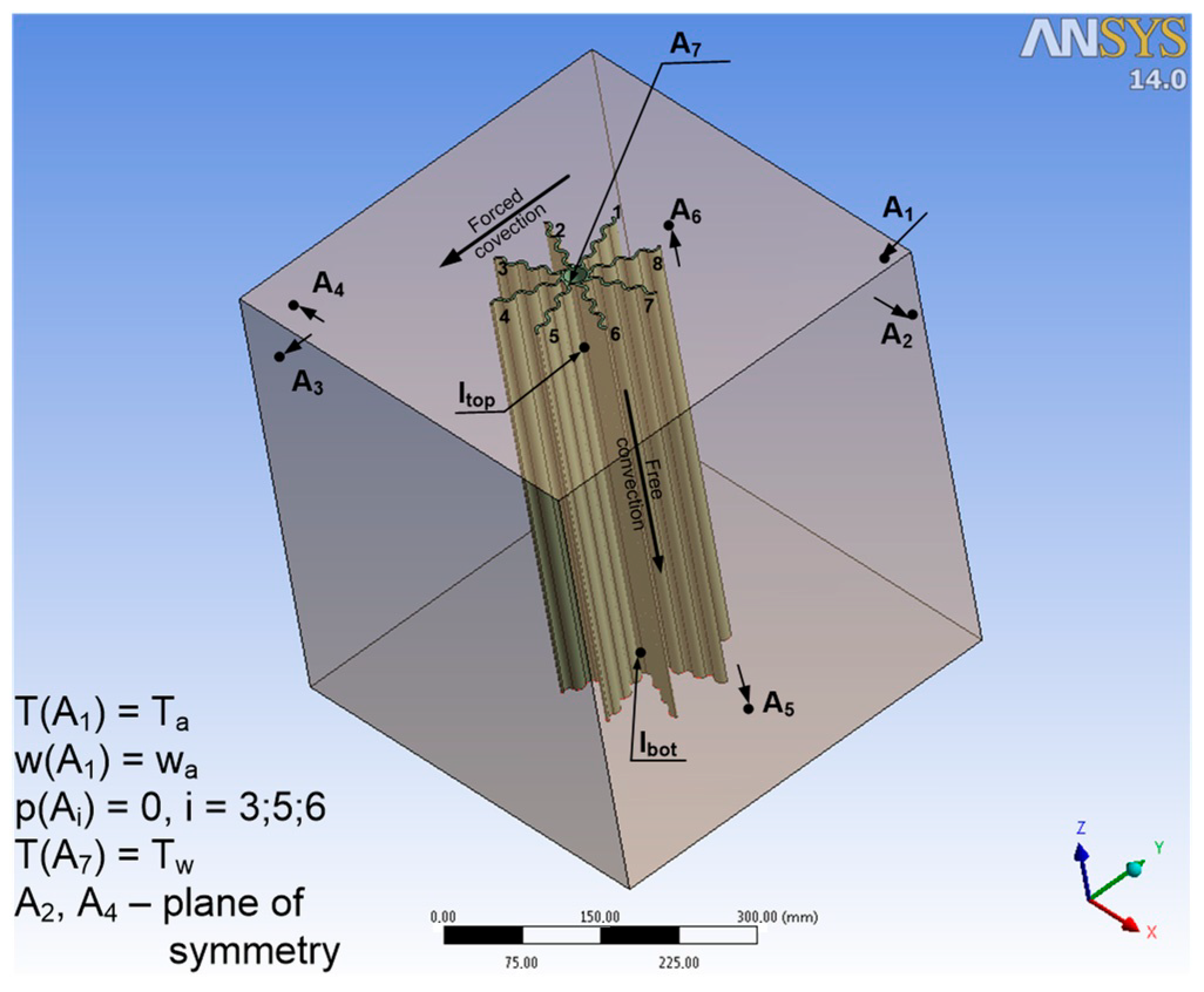
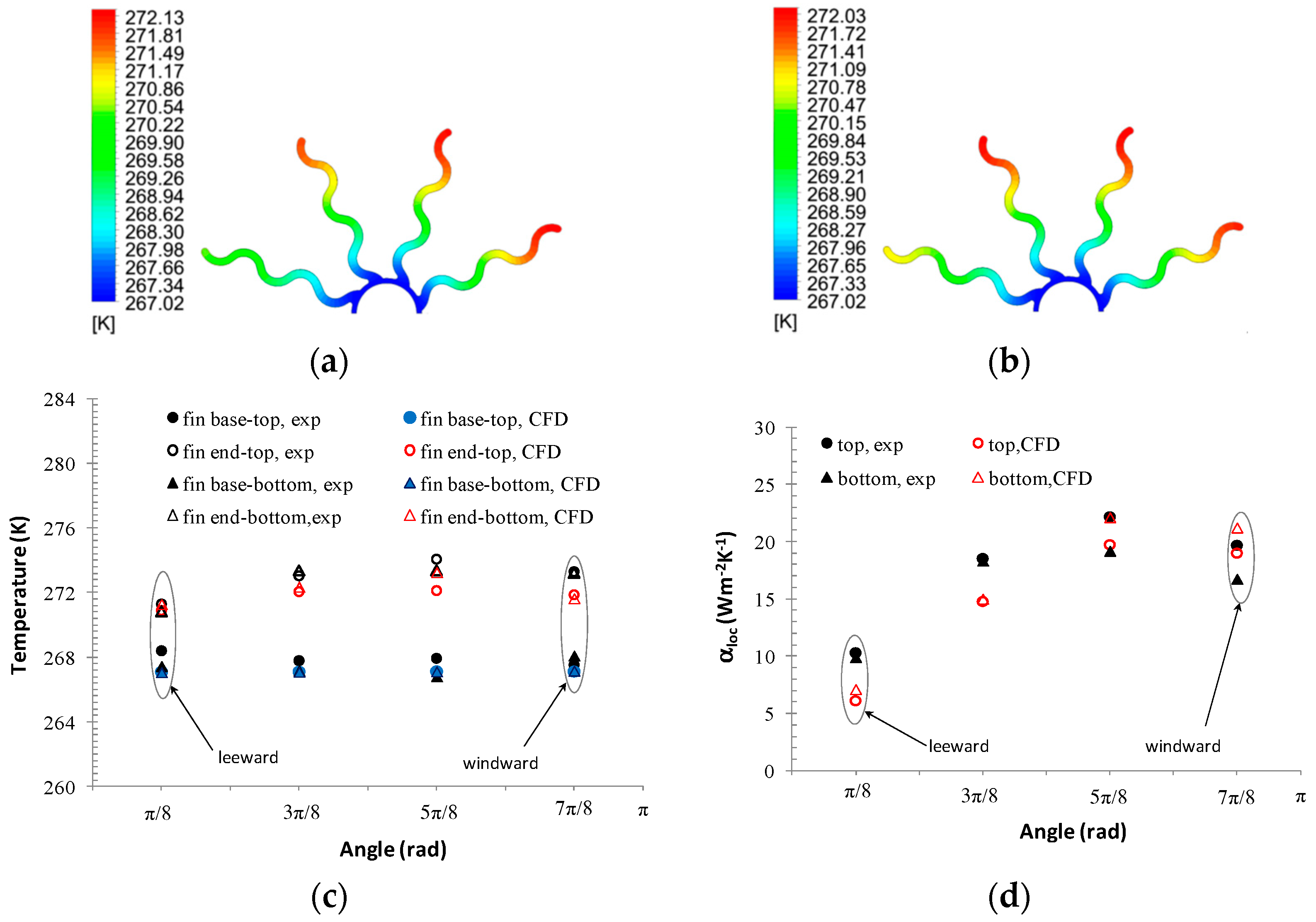
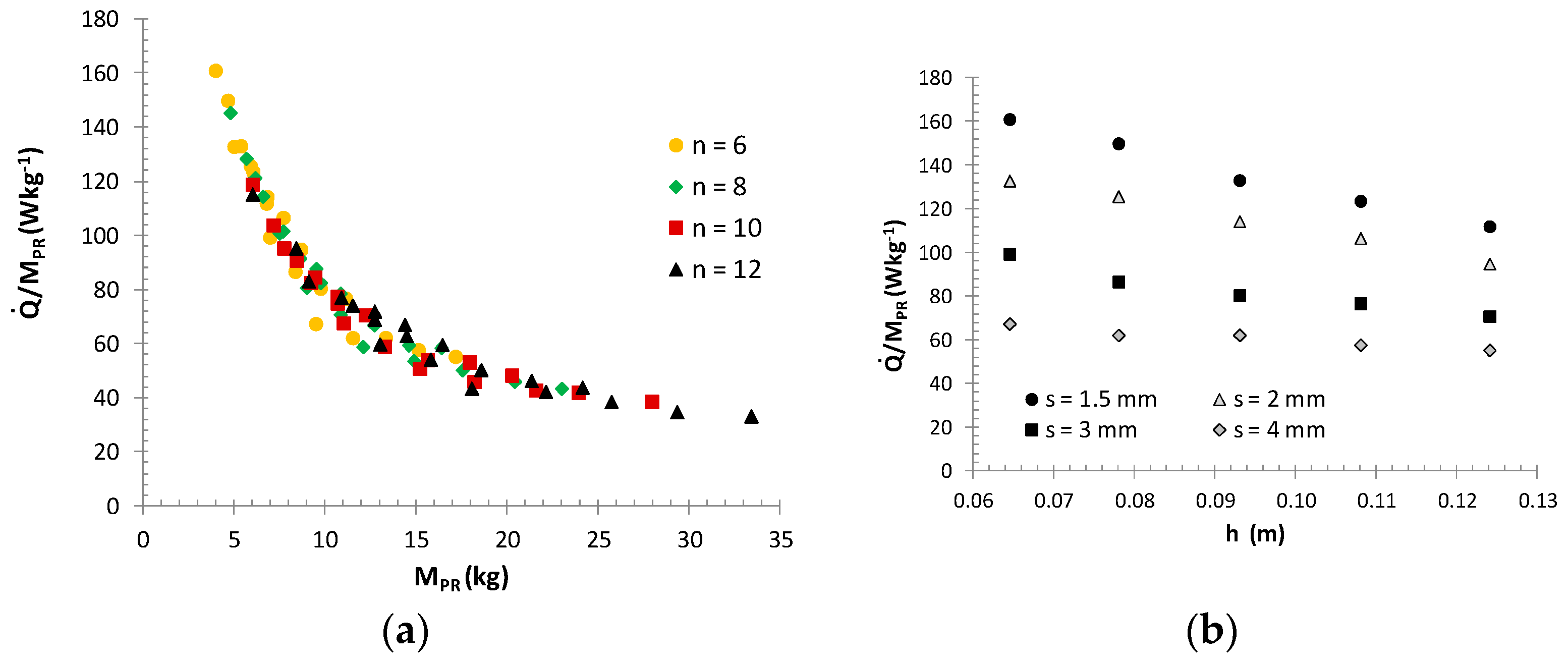
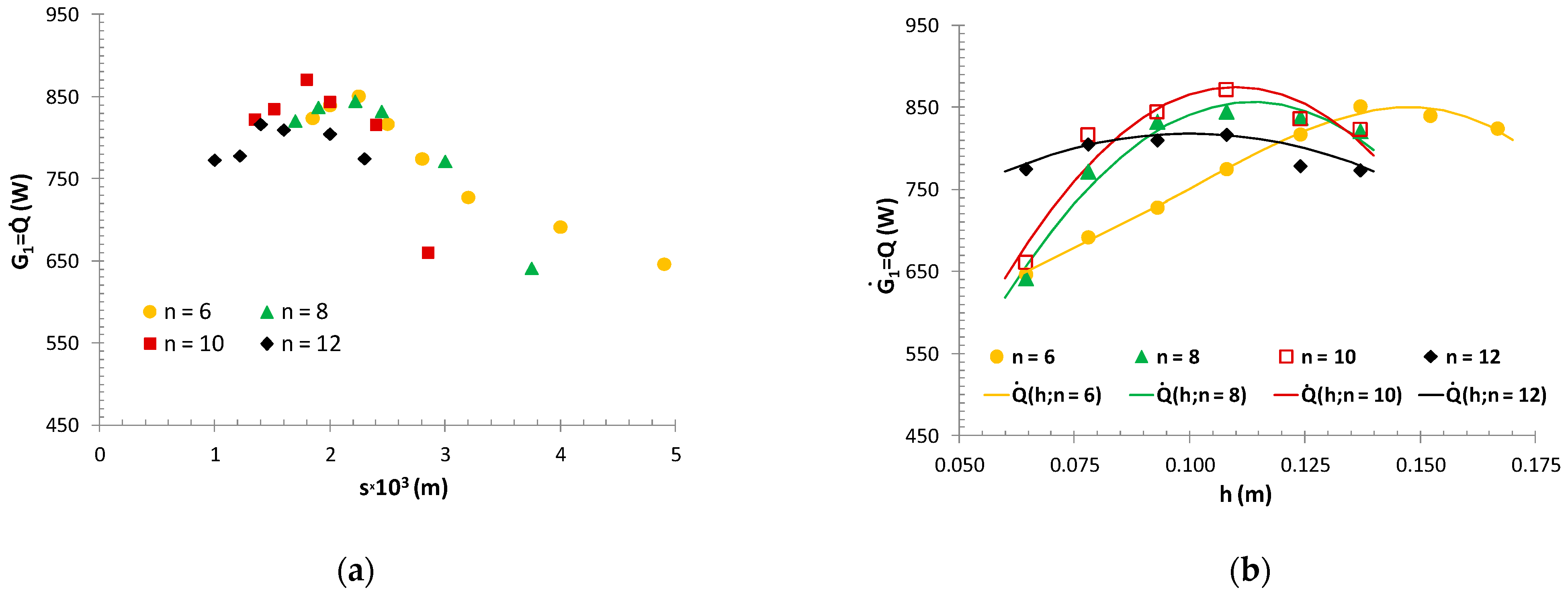
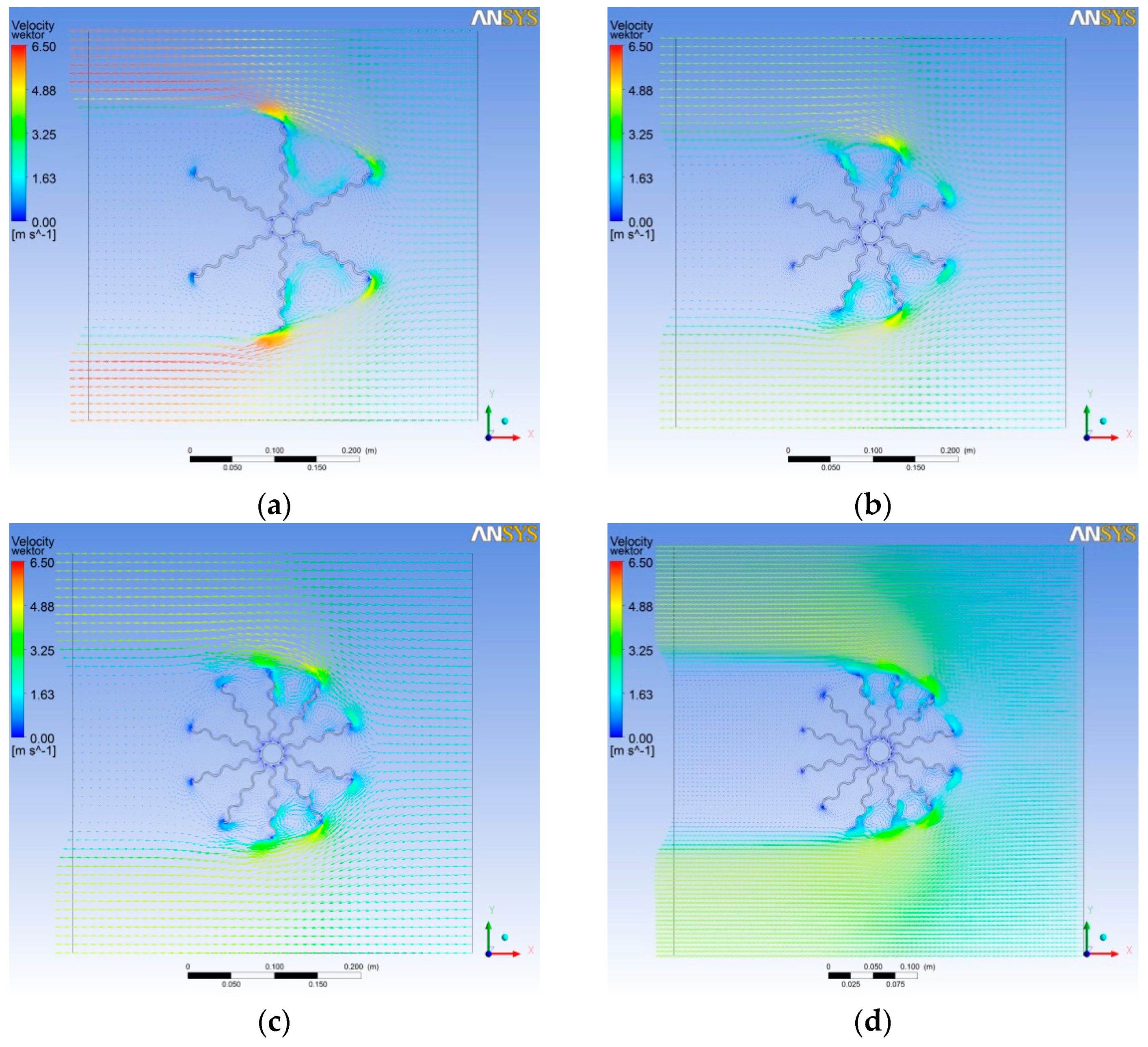
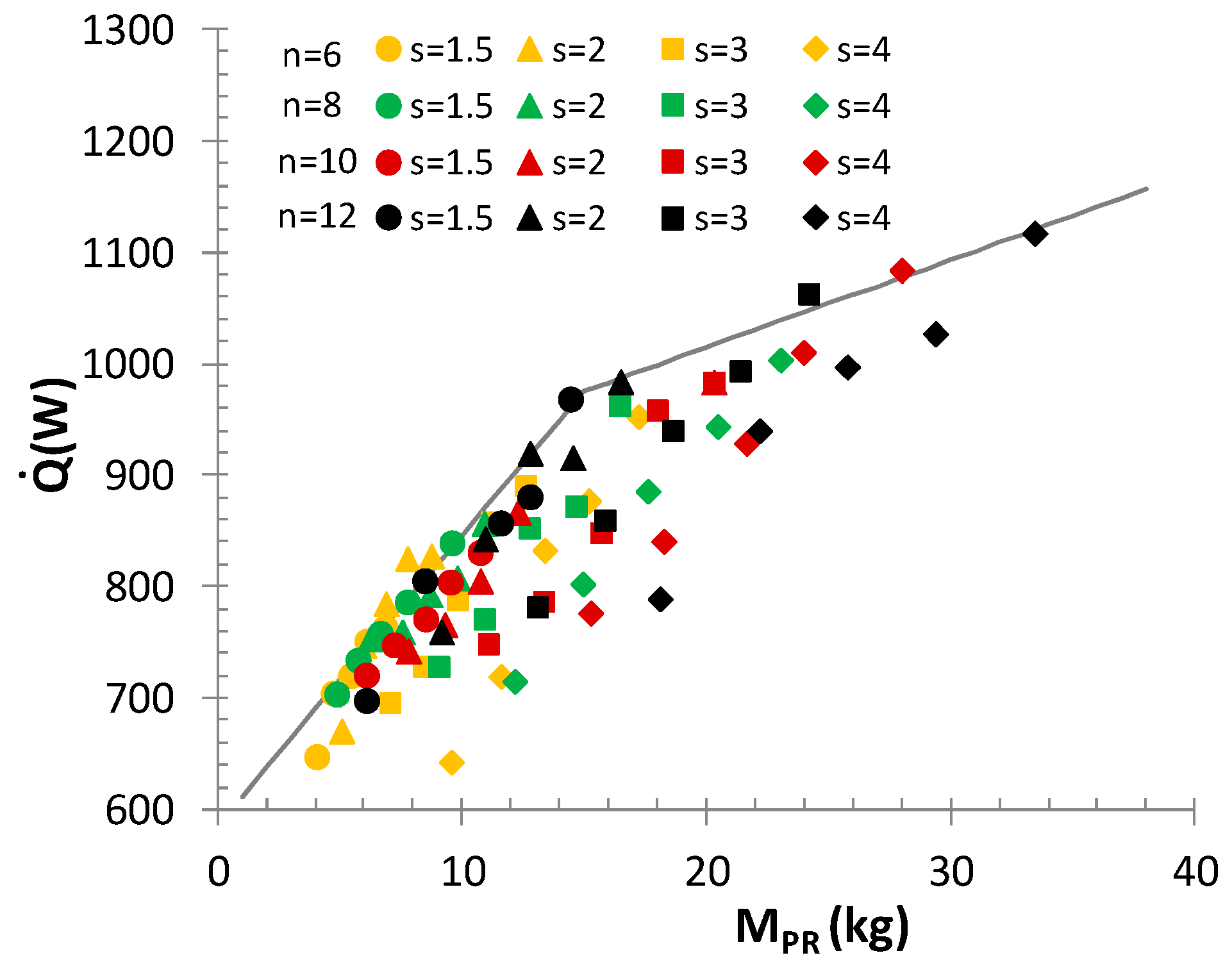
| n | a0 | a1 | a2 | a3 |
|---|---|---|---|---|
| 6 | 977.21 | 12,520.23 | 152,116.83 | 495,515.85 |
| 8 | −216.60 | 18,905.33 | −83,271.52 | 0 |
| 10 | −250.14 | 20,449.23 | −92,935.4 | 0 |
| 12 | 518.15 | 6109.04 | −32,099.01 | 10,132.31 |
| n | hopt3(m) | sopt × 103 (m) | |
|---|---|---|---|
| 6 | 850 | 0.160 | 2.24 |
| 8 | 856 | 0.114 | 2.19 |
| 10 1 | 875 | 0.110 | 1.80 |
| 12 | 818 | 0.100 | 1.65 |
| n | b0 | b1 | b2 |
|---|---|---|---|
| 6 | 1095.59 | −24.25 | −149.54 |
| 8 | 1194.83 | −25.33 | −234.25 |
| 10 | 1344.47 | −30.56 | −354.91 |
| 12 | 1434.12 | −31.42 | −410.01 |
Publisher’s Note: MDPI stays neutral with regard to jurisdictional claims in published maps and institutional affiliations. |
© 2021 by the authors. Licensee MDPI, Basel, Switzerland. This article is an open access article distributed under the terms and conditions of the Creative Commons Attribution (CC BY) license (http://creativecommons.org/licenses/by/4.0/).
Share and Cite
Kopeć, P.; Niezgoda-Żelasko, B. Optimisation of the Geometric Parameters of Longitudinally Finned Air Cooler Tubes Operating in Mixed Convection Conditions. Processes 2021, 9, 111. https://doi.org/10.3390/pr9010111
Kopeć P, Niezgoda-Żelasko B. Optimisation of the Geometric Parameters of Longitudinally Finned Air Cooler Tubes Operating in Mixed Convection Conditions. Processes. 2021; 9(1):111. https://doi.org/10.3390/pr9010111
Chicago/Turabian StyleKopeć, Piotr, and Beata Niezgoda-Żelasko. 2021. "Optimisation of the Geometric Parameters of Longitudinally Finned Air Cooler Tubes Operating in Mixed Convection Conditions" Processes 9, no. 1: 111. https://doi.org/10.3390/pr9010111
APA StyleKopeć, P., & Niezgoda-Żelasko, B. (2021). Optimisation of the Geometric Parameters of Longitudinally Finned Air Cooler Tubes Operating in Mixed Convection Conditions. Processes, 9(1), 111. https://doi.org/10.3390/pr9010111






